Spot bitcoin ETFs are finally here, attracting billions and challenging all pre-existing crypto-based ETFs. Does that spell the end for bitcoin futures funds? Not so fast. ProShares is doubling down.

For the 20 months leading up to January 2024, investors who wanted to put money into U.S. exchange-traded bitcoin funds were forced to play the bitcoin futures market.
The Securities and Exchange Commission (SEC) denied 30+ applications for funds that simply bought the premier cryptocurrency and parceled out their holdings as easy-to-trade shares listed on major stock exchanges, citing the susceptibility of the digital-assets market to manipulation.
Under a theory eventually judged to be “arbitrary and capricious” the SEC was okay with futures-based bitcoin funds, since the prices were verified under rules of regulated commodity exchanges. Nevermind that the futures prices are based on the spot-market for bitcoin.
So, starting with the ProShares Bitcoin Strategy ETF (BITO) in October 2021, 13 futures-based bitcoin ETFs were created.
Bethesda, MD-based ProShares was the first out of the gate and raised more than $1 billion the day it was offered, making it the most successful ETF launch in history.
Since then it has amassed about $2.5 billion of assets as of January 10 of this year, the day the SEC permitted 10 spot ETFs to begin trading.
With the advent of the spot bitcoin ETFs, which have amassed $34 billion of assets (including more that $28 billion converted from closed end fund GBTC) the outlook for futures-based crypto funds is suddenly uncertain.
“Investor appetite will switch from products offering bitcoin futures exposure to direct bitcoin exposure,” says Kyle DaCruz, VanEck’s director of digital-assets products. “Spot products should more closely track the price of bitcoin,” VanEck is not waiting around to watch the fate of futures-based bitcoin funds.
It closed its $43 million Bitcoin Strategy Fund (XBTF) futures ETF last month in favor of a new spot offering, the VanEck Bitcoin Trust (HODL), which holds $176 million currently.
ProShares, by contrast, is doubling down on its strategy. It has no plans to retire its Bitcoin Strategy ETF (BITO), which has $2 billion in assets, or convert it to a spot offering.
Instead it recently filed to offer a suite of complementary futures-based ETFs that add leverage to the funds’ indirect bitcoin investments. ProShares’ BITO has an expense ratio equal to 0.95% of the fund assets, about triple the level of the new spot offerings.
Bitcoin futures ETFs
Data as of February 14, 2024
| Inception date | Trust firm | ETF ticker | NAV 1/31 | Expense ratio | AUM, $m | AUM chg since 1/10 | Daily volume $m |
| 11/15/21 | Global X | BITS | $62.45 | 0.65% | $21 | -21% | $0.2 |
| 11/14/23 | Ark 21Shares | ARKA | $51.29 | 0.70% | $12 | 56% | $0.2 |
| 11/15/203 | Ark 21Shares | ARKC | $33.31 | 0.93% | $2 | 280% | $0.0 |
| 11/15/203 | Ark 21Shares | ARKY | $34.38 | 1.00% | $3 | 44% | $0.1 |
| 10/19/21 | ProShares | BITO | $24.56 | 0.95% | $2,092 | -8% | $398 |
| 10/21/21 | Valkyrie | BTF | $16.44 | 1.20% | $39 | 9% | $0.9 |
| 10/25/21 | VanEck | XBTF | $- | 0.66% | $43 | -26% | $- |
| 10/2/23 | ProShares | EETH | $65.57 | 0.95% | $29 | 30% | $3.0 |
| 10/2/23 | ProShares | BETH | $70.61 | 1.33% | $5 | 48% | $0.1 |
| 10/2/23 | ProShares | BETE | $68.06 | 1.33% | $3 | 33% | $0.1 |
| 9/15/22 | Hashdex | DEFI | $62.00 | 0.90% | $21 | 659% | $0.2 |
| 9/29/22 | Simplify | MAXI | $23.31 | 0.85% | $12 | -64% | $0.5 |
| 6/21/22 | ProShares | BITI | $10.42 | 1.33% | $66 | 21% | $26 |
| Total | $2,346 | $429 |
Background
BITO and similar ETFs purchase cash-settled futures contracts at regulated exchanges like the Chicago Mercantile Exchange (CME) and package them as shares that freely trade on the stock market.
These products differ from the new spot ETFs, whose issuers procure physical bitcoin and then offer shares that represent fractional interests in the portfolios of bitcoins.
Futures ETFs can be more complicated and expensive because issuers need to keep purchasing new contracts at each expiry (usually at the end of a month), and hidden rollover costs can eat into profits if the bitcoin price starts to climb.
As the chart below demonstrates, BITO has trailed its benchmark, the Bloomberg Galaxy Bitcoin Index, since inception by eight percentage points through January 30.
Note that there is a difference between the cumulative and spot price returns because the cumulative return includes additional factors such as dividend payments and interest on the fund’s cash. Pure spot ETFs do not yet pay dividends.
BITO performance
Performance since inception relative to its BTC Index benchmark
Dark green: BITO Price Return (excl. dividend reinvestment)
Green: BITO Cumulative Total Return (incl. dividend reinvestment)
Yellow: BTC Index % return
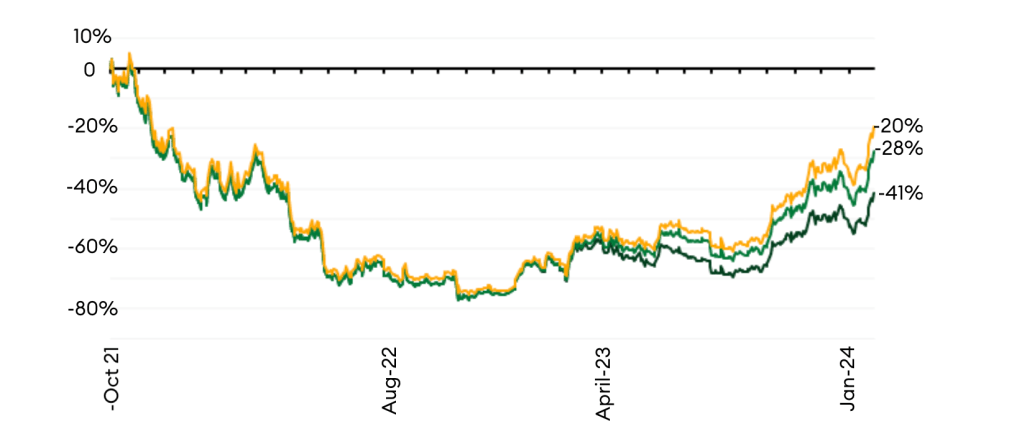
Given these extra mechanics and added costs, it may surprise some observers that the SEC approved futures products first.
However, Chairman Gary Gensler (who used to oversee the Commodity Futures Trading Commission, regulator of the futures market) felt more comfortable with ETFs that track products traded on a regulated exchange rather than the largely unregulated world of cryptocurrency trading.
Thanks to its strong launch ProShares’ BITO has a 90% market share among bitcoin futures funds.
BITO’s assets under management decreased by $126 million between January 10 and February 16, but its total is still up by $1.3 billion from mid-October 2023, when institutional investors started buying into the ETF as a bullish bet on bitcoin in anticipation of the SEC approving the long-awaited spot ETFs.
It is difficult to determine the precise reasons for the significant BITO outflows since January 11, and a good portion may be due to profit-taking by short-term buyers.
Some $93 million can be attributed to Cathie Wood’s Ark Invest moving holdings from BITO into her firm’s spot ETF, Ark 21Shares Bitcoin ETF.
BITO ETF Assets Under Management
AUM since October 2021
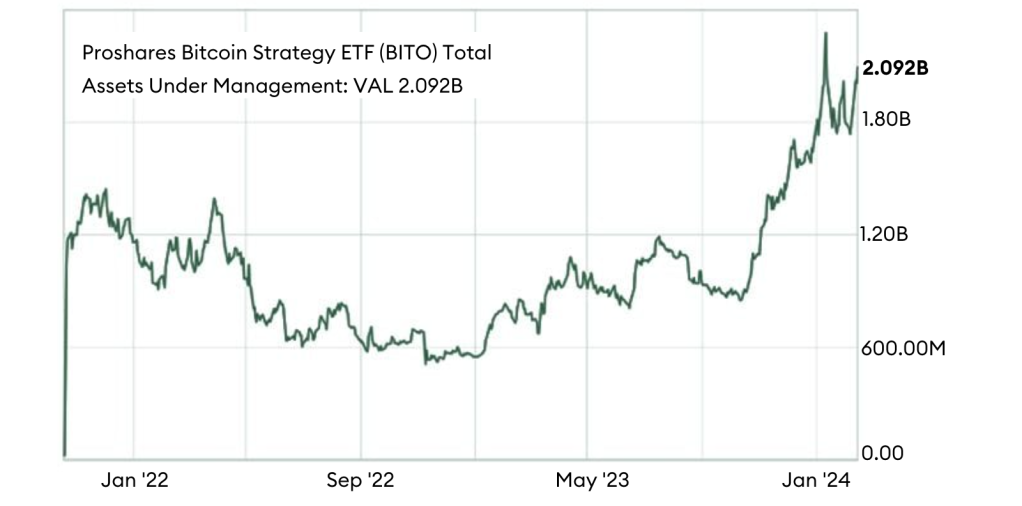
Key stats
BITO – Bitcoin Equivalent Holdings
Daily holdings change, in bitcoin equivalent
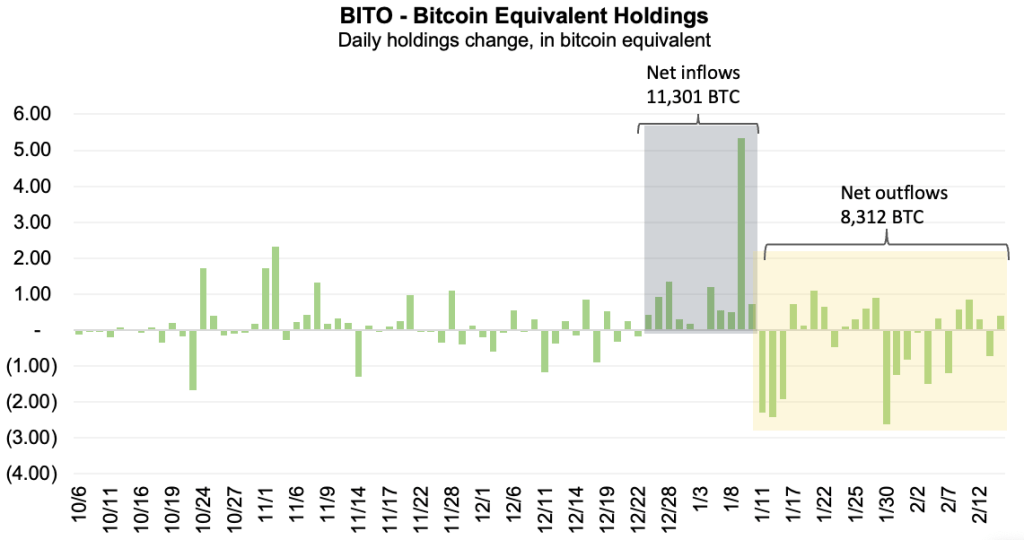
Bitcoin or equivalent added
Bitcoin or bitcoin equivalent acquired (lost) from Jan. 11, 2024 to February 14, 2024
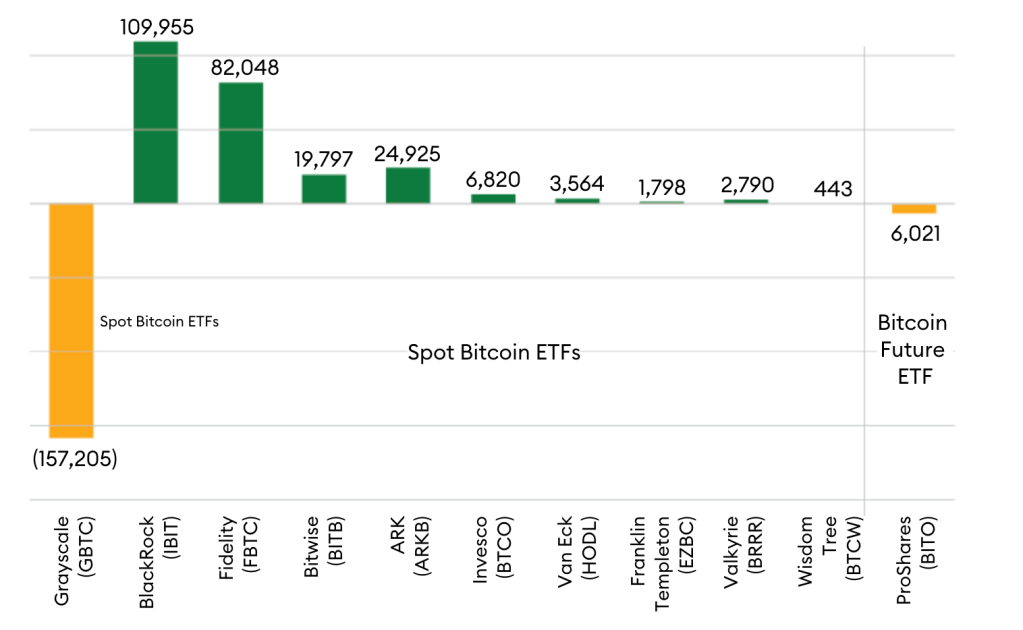
Trading volume comparison
Daily volume in $ millions, average from 1/11 and volume on 2/14
Green: Average trading volume, last 24 sessions, in $ millions
Yellow: Latest day activity, in $m
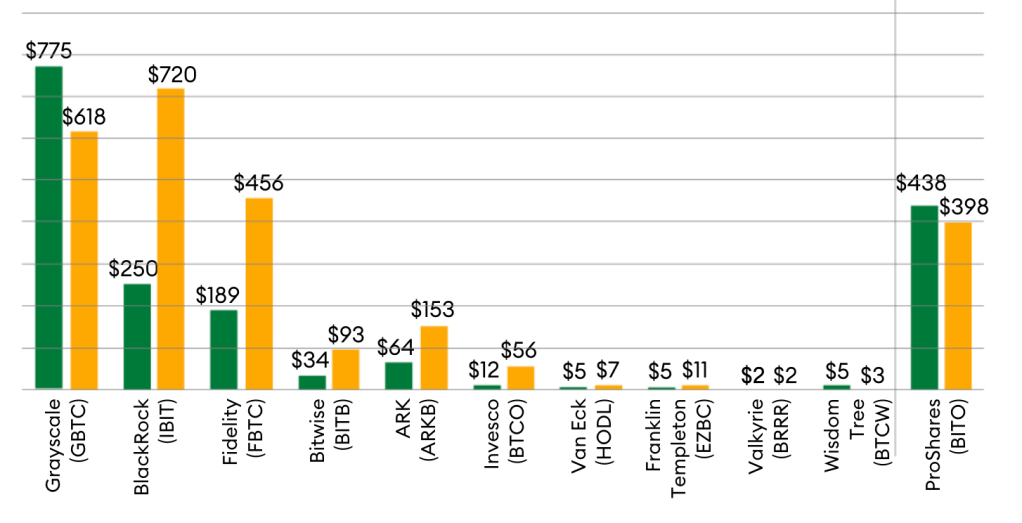
Outlook and implications
Proshare’s BITO has a solid revenue stream based on its 0.95% expense ratio on approximately $2 billion in assets, or approximately $19 million a year.
If ProShares were to convert to a spot ETF it would likely have to cut the expense ratio by two thirds (though its costs would also come down) to match the competition. BITO is just one of more than 40 exchange traded products offered by ProShares which has a total AUM of $64 billion.
The company appears to be taking a similar approach to Bitcoin Trust (GBTC), which had a 2% expense ratio in its previous incarnation as a closed-end fund and only lowered that to 1.5% when it changed format to become an ETF.
That compares with expense ratios of about 0.26% for most of the new crop of spot ETF competitors.
ProShares’ public statements mirror those from Grayscale CEO Michael Sonnenshein, who has tried to justify GBTC’s higher costs by focusing on experience, operational efficiency, liquidity and tight bid-ask spreads.
“We believe the continued success of BITO is due to many investors wanting to gain bitcoin exposure through a fund that invests in an orderly, efficient and highly regulated marketplace and custodies with one of the world’s largest banks [JPMorgan],” says ProShares CEO Michael Sapir.
It’s possible that BITO’s steep expense ratio relative to its spot ETF rivals may never prompt a flood of redemptions. Inertia has long been a powerful force in investment management. About “75% to 80% of AUM is in exchange trade funds over 15 years old,” says hanETF founder Hector McNeil. “They are so embedded in the financial platforms and systems they just harvest money.”
Another factor keeping investors in ProShares’ higher cost fund could be taxes, specifically in comparison to the capital-gains taxes that for some BITO holders with large paper profits.
But what about new money? Are there reasons for an investor to allocate into futures ETFs instead of spot bitcoin funds? That is a more difficult argument.
It turns out that futures-based commodity ETFs make more sense for some assets than others. Crude oil, for example, is difficult to store.
“The trouble is when you’ve got spot you need to warehouse it in big tanks, says McNeil. ”There’s a cost to carry when you store the physical product.” However, he noted that spot gold ETFs don’t present the same challenges. “Gold is easy because it’s very valuable, small and fits in a vault…Plus there is a liquid spot market.” Since bitcoin is marketed as a form of digital gold and is even cheaper and easier to store, the gold example is more relevant.
A futures-based fund could outperform bitcoin in a falling cryptocurrency market.
While BITO may struggle to keep up with spot prices during periods of contango, when futures prices are highest for long-term contracts, the opposite could work in BITO’s favor during bearish times when rollover costs increasingly get cheaper, known as backwardation.
“A futures ETF is a more sophisticated product, so it’s going to be less appropriate for the majority of people,” says Ophelia Snyder, co-founder and president of 21.co. “It’s a tactical strategic product, not a buy-and-hold product.”
What is ahead for ProShares
While ProShares Bitcoin Strategy ETF continues to be the firm’s flagship crypto fund, the asset manager recently filed to launch five other ETFs that would deal in swap agreements, a novel type of bitcoin exposure.
These funds would also use North American spot ETFs but not direct positions in the cryptocurrencies and seek to provide leveraged daily returns based on the Bloomberg Galaxy Bitcoin Index:
Investment objective of proposed ProShares ETF
- ProShares Ultra Bitcoin ETF – 2.0 times the index.
- ProShares Plus Bitcoin ETF – 1.5 times the index.
- ProShares Short Bitcoin ETF – 1.0 times the inverse of the index.
- ProShares ShortPlus Bitcoin ETF – 1.5 times the inverse of the index.
- ProShares UltraShort Bitcoin ETF – 2.0 times the inverse of the index.
Source: U.S. Sec, ProShares filings
ProShares is targeting traders seeking financial leverage as a differentiator from spot ETFs, which don’t use leverage to magnify returns.
These riskier funds are not yet approved to begin trading, but they are likely to be allowed to list given that the SEC has already approved other products that offer multi-directional bets and leverage on the price of bitcoin.
ProShares’ second-largest crypto futures ETF, ProShares Short Bitcoin Strategy ETF (BITI) ($58 million in assets) also targets a 1.0 times inverse return on bitcoin’s price but differs because it primarily sells bitcoin futures contracts to meet its investment objective.
Despite the higher costs associated with its products, ProShares BITO’s dominant position among bitcoin futures ETFs gives it a firm footing among sophisticated crypto traders.
ProShares is in the process of creating an ecosystem of leveraged products that should appeal to institutional investors looking to magnify gains or hedge risk.
ProShares faces competition from similar products offered by other issuers including Hashdex, GlobalX and Ark21 Shares assuming that they remain operational.
This article was first published on forbes.com and all figures are in USD.


